LST5CCL Company & Commercial Law: Partnership and Liability Analysis
VerifiedAdded on 2023/06/11
|12
|3092
|226
Case Study
AI Summary
This case study examines partnership and liability issues within a company law context. It analyzes whether a partnership exists between individuals based on the Partnership Act (Vic) 1958, focusing on elements like carrying on a business, commonality, and profit motive. The study also explores liability for damages resulting from negligent advice, considering duty of care, standard of care, and remoteness of damages. The analysis references relevant case law such as Goudberg v Herniman Associates Pty Ltd, Hedley Byrne v Heller, and Rogers v Whitaker to determine the extent of liability for partners and the impact of incorrect advice on third parties. Desklib provides access to similar case studies and solved assignments for students.
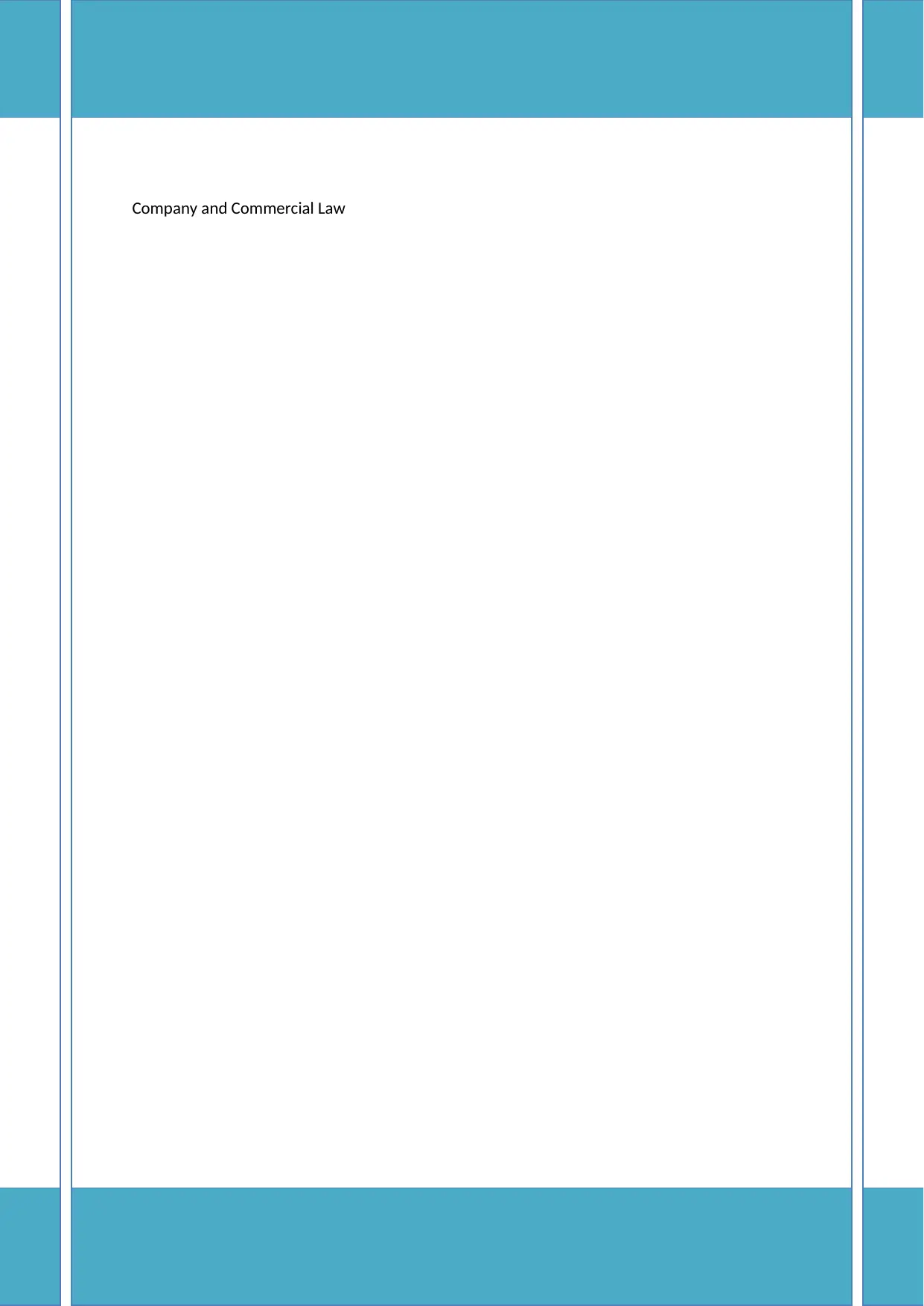
Company and Commercial Law
Paraphrase This Document
Need a fresh take? Get an instant paraphrase of this document with our AI Paraphraser
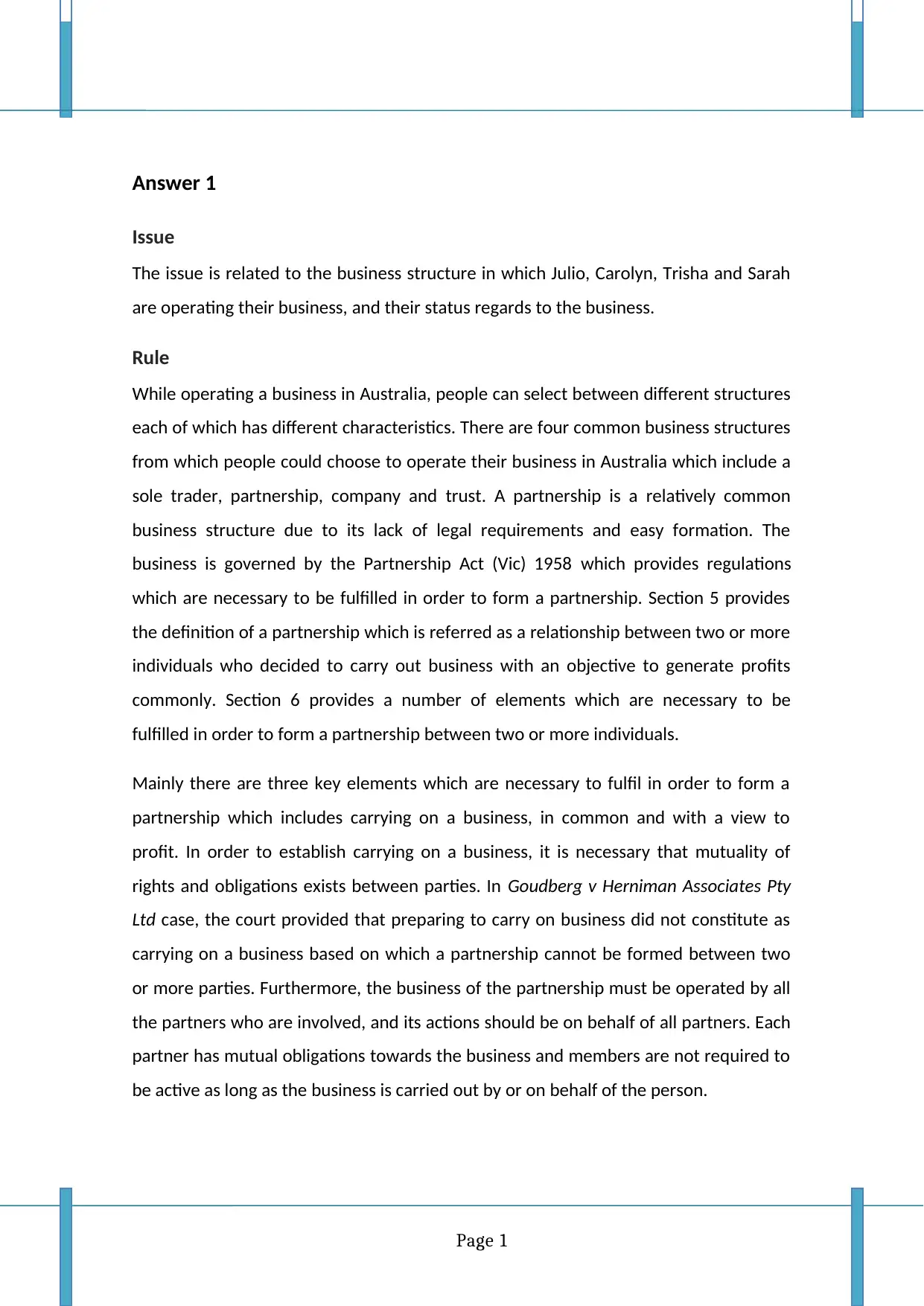
Answer 1
Issue
The issue is related to the business structure in which Julio, Carolyn, Trisha and Sarah
are operating their business, and their status regards to the business.
Rule
While operating a business in Australia, people can select between different structures
each of which has different characteristics. There are four common business structures
from which people could choose to operate their business in Australia which include a
sole trader, partnership, company and trust. A partnership is a relatively common
business structure due to its lack of legal requirements and easy formation. The
business is governed by the Partnership Act (Vic) 1958 which provides regulations
which are necessary to be fulfilled in order to form a partnership. Section 5 provides
the definition of a partnership which is referred as a relationship between two or more
individuals who decided to carry out business with an objective to generate profits
commonly. Section 6 provides a number of elements which are necessary to be
fulfilled in order to form a partnership between two or more individuals.
Mainly there are three key elements which are necessary to fulfil in order to form a
partnership which includes carrying on a business, in common and with a view to
profit. In order to establish carrying on a business, it is necessary that mutuality of
rights and obligations exists between parties. In Goudberg v Herniman Associates Pty
Ltd case, the court provided that preparing to carry on business did not constitute as
carrying on a business based on which a partnership cannot be formed between two
or more parties. Furthermore, the business of the partnership must be operated by all
the partners who are involved, and its actions should be on behalf of all partners. Each
partner has mutual obligations towards the business and members are not required to
be active as long as the business is carried out by or on behalf of the person.
Page 1
Issue
The issue is related to the business structure in which Julio, Carolyn, Trisha and Sarah
are operating their business, and their status regards to the business.
Rule
While operating a business in Australia, people can select between different structures
each of which has different characteristics. There are four common business structures
from which people could choose to operate their business in Australia which include a
sole trader, partnership, company and trust. A partnership is a relatively common
business structure due to its lack of legal requirements and easy formation. The
business is governed by the Partnership Act (Vic) 1958 which provides regulations
which are necessary to be fulfilled in order to form a partnership. Section 5 provides
the definition of a partnership which is referred as a relationship between two or more
individuals who decided to carry out business with an objective to generate profits
commonly. Section 6 provides a number of elements which are necessary to be
fulfilled in order to form a partnership between two or more individuals.
Mainly there are three key elements which are necessary to fulfil in order to form a
partnership which includes carrying on a business, in common and with a view to
profit. In order to establish carrying on a business, it is necessary that mutuality of
rights and obligations exists between parties. In Goudberg v Herniman Associates Pty
Ltd case, the court provided that preparing to carry on business did not constitute as
carrying on a business based on which a partnership cannot be formed between two
or more parties. Furthermore, the business of the partnership must be operated by all
the partners who are involved, and its actions should be on behalf of all partners. Each
partner has mutual obligations towards the business and members are not required to
be active as long as the business is carried out by or on behalf of the person.
Page 1
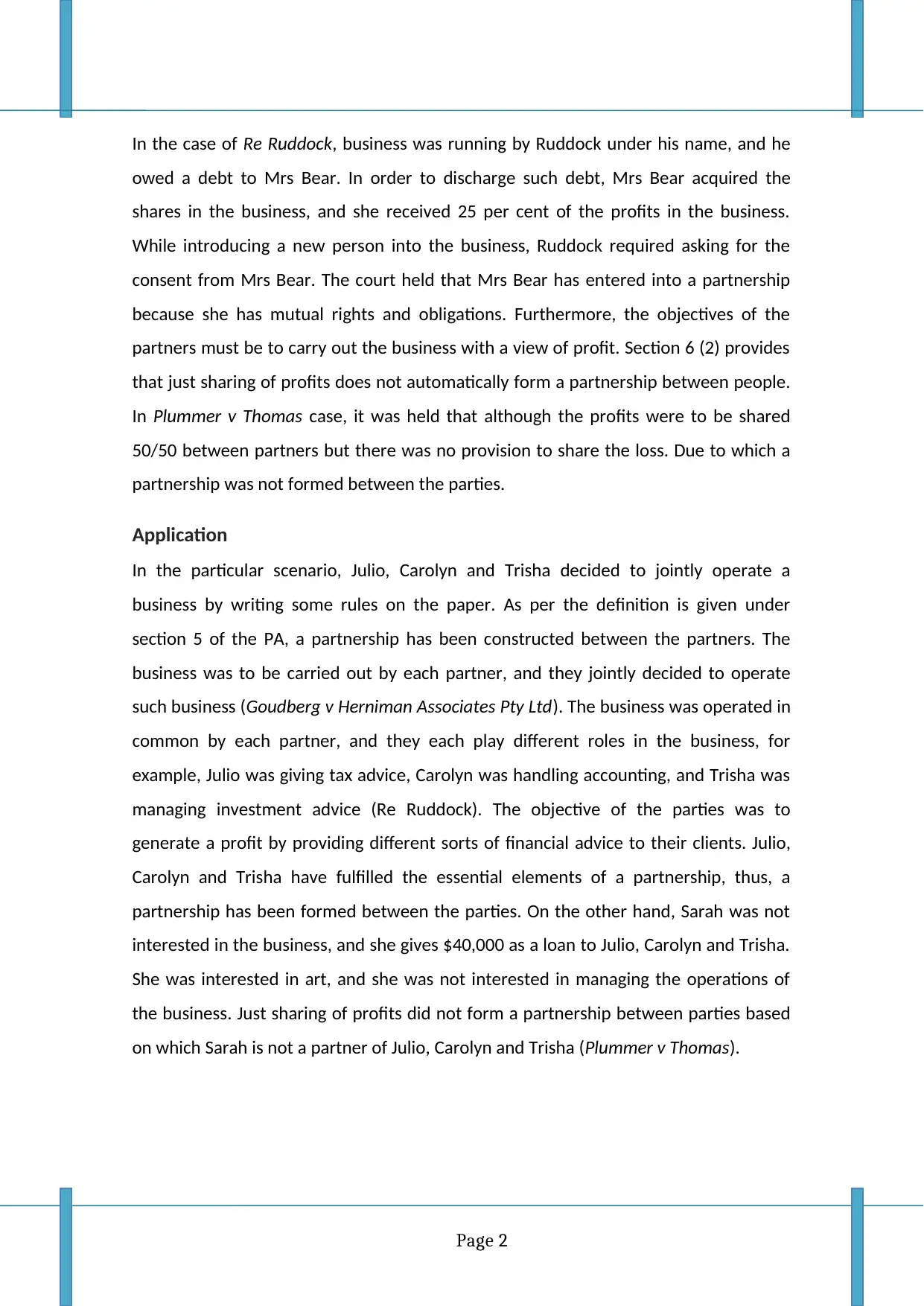
In the case of Re Ruddock, business was running by Ruddock under his name, and he
owed a debt to Mrs Bear. In order to discharge such debt, Mrs Bear acquired the
shares in the business, and she received 25 per cent of the profits in the business.
While introducing a new person into the business, Ruddock required asking for the
consent from Mrs Bear. The court held that Mrs Bear has entered into a partnership
because she has mutual rights and obligations. Furthermore, the objectives of the
partners must be to carry out the business with a view of profit. Section 6 (2) provides
that just sharing of profits does not automatically form a partnership between people.
In Plummer v Thomas case, it was held that although the profits were to be shared
50/50 between partners but there was no provision to share the loss. Due to which a
partnership was not formed between the parties.
Application
In the particular scenario, Julio, Carolyn and Trisha decided to jointly operate a
business by writing some rules on the paper. As per the definition is given under
section 5 of the PA, a partnership has been constructed between the partners. The
business was to be carried out by each partner, and they jointly decided to operate
such business (Goudberg v Herniman Associates Pty Ltd). The business was operated in
common by each partner, and they each play different roles in the business, for
example, Julio was giving tax advice, Carolyn was handling accounting, and Trisha was
managing investment advice (Re Ruddock). The objective of the parties was to
generate a profit by providing different sorts of financial advice to their clients. Julio,
Carolyn and Trisha have fulfilled the essential elements of a partnership, thus, a
partnership has been formed between the parties. On the other hand, Sarah was not
interested in the business, and she gives $40,000 as a loan to Julio, Carolyn and Trisha.
She was interested in art, and she was not interested in managing the operations of
the business. Just sharing of profits did not form a partnership between parties based
on which Sarah is not a partner of Julio, Carolyn and Trisha (Plummer v Thomas).
Page 2
owed a debt to Mrs Bear. In order to discharge such debt, Mrs Bear acquired the
shares in the business, and she received 25 per cent of the profits in the business.
While introducing a new person into the business, Ruddock required asking for the
consent from Mrs Bear. The court held that Mrs Bear has entered into a partnership
because she has mutual rights and obligations. Furthermore, the objectives of the
partners must be to carry out the business with a view of profit. Section 6 (2) provides
that just sharing of profits does not automatically form a partnership between people.
In Plummer v Thomas case, it was held that although the profits were to be shared
50/50 between partners but there was no provision to share the loss. Due to which a
partnership was not formed between the parties.
Application
In the particular scenario, Julio, Carolyn and Trisha decided to jointly operate a
business by writing some rules on the paper. As per the definition is given under
section 5 of the PA, a partnership has been constructed between the partners. The
business was to be carried out by each partner, and they jointly decided to operate
such business (Goudberg v Herniman Associates Pty Ltd). The business was operated in
common by each partner, and they each play different roles in the business, for
example, Julio was giving tax advice, Carolyn was handling accounting, and Trisha was
managing investment advice (Re Ruddock). The objective of the parties was to
generate a profit by providing different sorts of financial advice to their clients. Julio,
Carolyn and Trisha have fulfilled the essential elements of a partnership, thus, a
partnership has been formed between the parties. On the other hand, Sarah was not
interested in the business, and she gives $40,000 as a loan to Julio, Carolyn and Trisha.
She was interested in art, and she was not interested in managing the operations of
the business. Just sharing of profits did not form a partnership between parties based
on which Sarah is not a partner of Julio, Carolyn and Trisha (Plummer v Thomas).
Page 2
⊘ This is a preview!⊘
Do you want full access?
Subscribe today to unlock all pages.

Trusted by 1+ million students worldwide
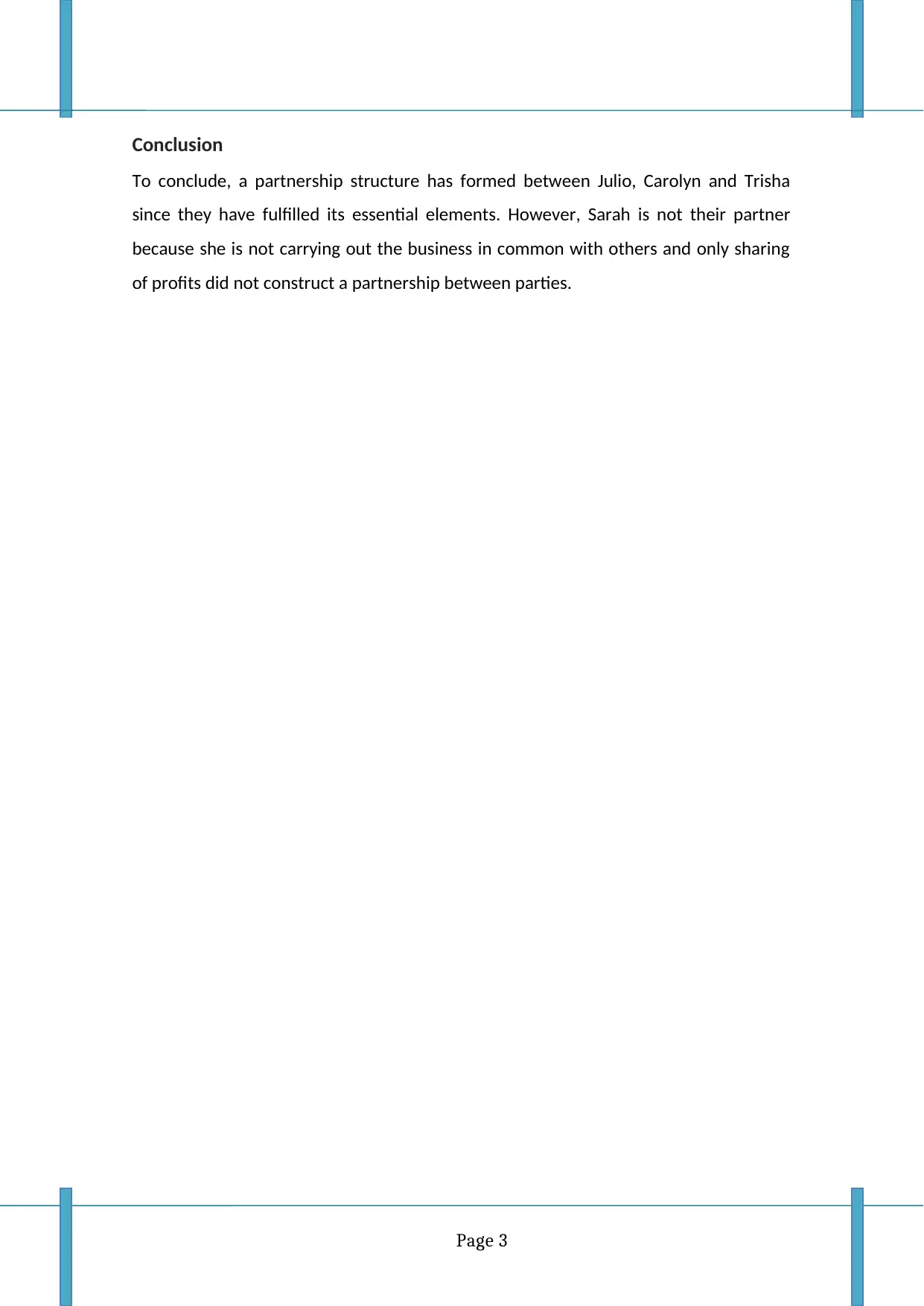
Conclusion
To conclude, a partnership structure has formed between Julio, Carolyn and Trisha
since they have fulfilled its essential elements. However, Sarah is not their partner
because she is not carrying out the business in common with others and only sharing
of profits did not construct a partnership between parties.
Page 3
To conclude, a partnership structure has formed between Julio, Carolyn and Trisha
since they have fulfilled its essential elements. However, Sarah is not their partner
because she is not carrying out the business in common with others and only sharing
of profits did not construct a partnership between parties.
Page 3
Paraphrase This Document
Need a fresh take? Get an instant paraphrase of this document with our AI Paraphraser
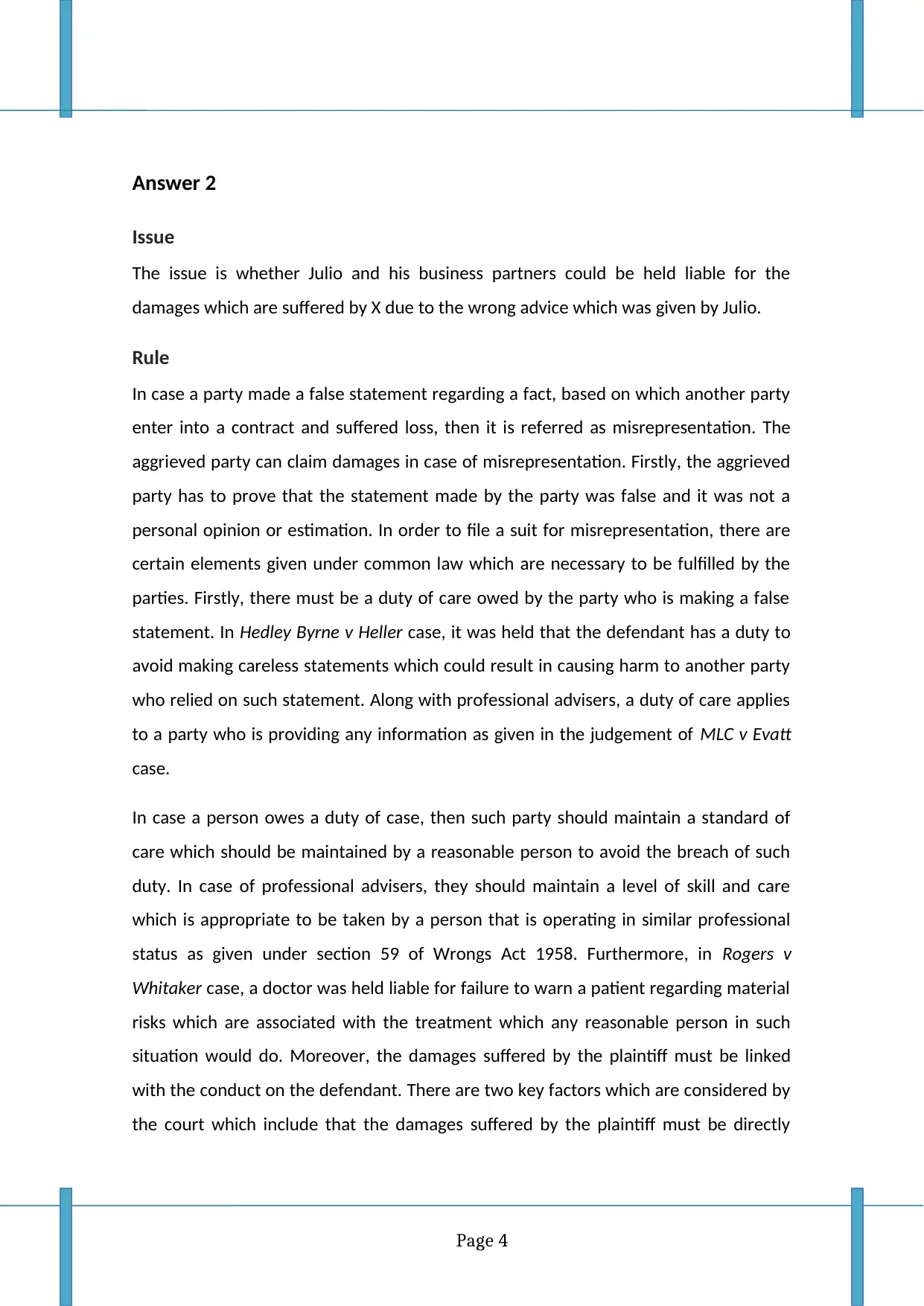
Answer 2
Issue
The issue is whether Julio and his business partners could be held liable for the
damages which are suffered by X due to the wrong advice which was given by Julio.
Rule
In case a party made a false statement regarding a fact, based on which another party
enter into a contract and suffered loss, then it is referred as misrepresentation. The
aggrieved party can claim damages in case of misrepresentation. Firstly, the aggrieved
party has to prove that the statement made by the party was false and it was not a
personal opinion or estimation. In order to file a suit for misrepresentation, there are
certain elements given under common law which are necessary to be fulfilled by the
parties. Firstly, there must be a duty of care owed by the party who is making a false
statement. In Hedley Byrne v Heller case, it was held that the defendant has a duty to
avoid making careless statements which could result in causing harm to another party
who relied on such statement. Along with professional advisers, a duty of care applies
to a party who is providing any information as given in the judgement of MLC v Evatt
case.
In case a person owes a duty of case, then such party should maintain a standard of
care which should be maintained by a reasonable person to avoid the breach of such
duty. In case of professional advisers, they should maintain a level of skill and care
which is appropriate to be taken by a person that is operating in similar professional
status as given under section 59 of Wrongs Act 1958. Furthermore, in Rogers v
Whitaker case, a doctor was held liable for failure to warn a patient regarding material
risks which are associated with the treatment which any reasonable person in such
situation would do. Moreover, the damages suffered by the plaintiff must be linked
with the conduct on the defendant. There are two key factors which are considered by
the court which include that the damages suffered by the plaintiff must be directly
Page 4
Issue
The issue is whether Julio and his business partners could be held liable for the
damages which are suffered by X due to the wrong advice which was given by Julio.
Rule
In case a party made a false statement regarding a fact, based on which another party
enter into a contract and suffered loss, then it is referred as misrepresentation. The
aggrieved party can claim damages in case of misrepresentation. Firstly, the aggrieved
party has to prove that the statement made by the party was false and it was not a
personal opinion or estimation. In order to file a suit for misrepresentation, there are
certain elements given under common law which are necessary to be fulfilled by the
parties. Firstly, there must be a duty of care owed by the party who is making a false
statement. In Hedley Byrne v Heller case, it was held that the defendant has a duty to
avoid making careless statements which could result in causing harm to another party
who relied on such statement. Along with professional advisers, a duty of care applies
to a party who is providing any information as given in the judgement of MLC v Evatt
case.
In case a person owes a duty of case, then such party should maintain a standard of
care which should be maintained by a reasonable person to avoid the breach of such
duty. In case of professional advisers, they should maintain a level of skill and care
which is appropriate to be taken by a person that is operating in similar professional
status as given under section 59 of Wrongs Act 1958. Furthermore, in Rogers v
Whitaker case, a doctor was held liable for failure to warn a patient regarding material
risks which are associated with the treatment which any reasonable person in such
situation would do. Moreover, the damages suffered by the plaintiff must be linked
with the conduct on the defendant. There are two key factors which are considered by
the court which include that the damages suffered by the plaintiff must be directly
Page 4
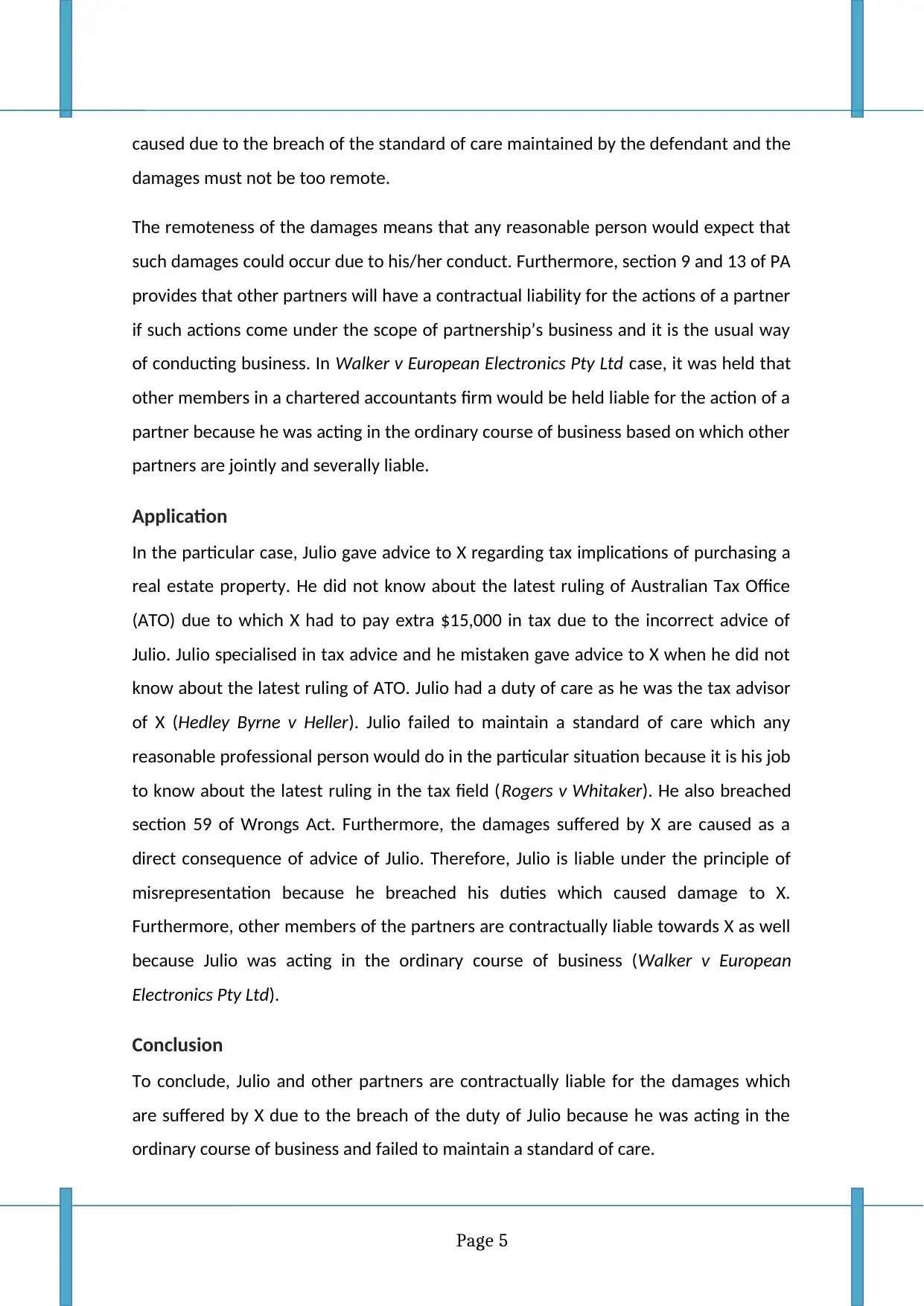
caused due to the breach of the standard of care maintained by the defendant and the
damages must not be too remote.
The remoteness of the damages means that any reasonable person would expect that
such damages could occur due to his/her conduct. Furthermore, section 9 and 13 of PA
provides that other partners will have a contractual liability for the actions of a partner
if such actions come under the scope of partnership’s business and it is the usual way
of conducting business. In Walker v European Electronics Pty Ltd case, it was held that
other members in a chartered accountants firm would be held liable for the action of a
partner because he was acting in the ordinary course of business based on which other
partners are jointly and severally liable.
Application
In the particular case, Julio gave advice to X regarding tax implications of purchasing a
real estate property. He did not know about the latest ruling of Australian Tax Office
(ATO) due to which X had to pay extra $15,000 in tax due to the incorrect advice of
Julio. Julio specialised in tax advice and he mistaken gave advice to X when he did not
know about the latest ruling of ATO. Julio had a duty of care as he was the tax advisor
of X (Hedley Byrne v Heller). Julio failed to maintain a standard of care which any
reasonable professional person would do in the particular situation because it is his job
to know about the latest ruling in the tax field (Rogers v Whitaker). He also breached
section 59 of Wrongs Act. Furthermore, the damages suffered by X are caused as a
direct consequence of advice of Julio. Therefore, Julio is liable under the principle of
misrepresentation because he breached his duties which caused damage to X.
Furthermore, other members of the partners are contractually liable towards X as well
because Julio was acting in the ordinary course of business (Walker v European
Electronics Pty Ltd).
Conclusion
To conclude, Julio and other partners are contractually liable for the damages which
are suffered by X due to the breach of the duty of Julio because he was acting in the
ordinary course of business and failed to maintain a standard of care.
Page 5
damages must not be too remote.
The remoteness of the damages means that any reasonable person would expect that
such damages could occur due to his/her conduct. Furthermore, section 9 and 13 of PA
provides that other partners will have a contractual liability for the actions of a partner
if such actions come under the scope of partnership’s business and it is the usual way
of conducting business. In Walker v European Electronics Pty Ltd case, it was held that
other members in a chartered accountants firm would be held liable for the action of a
partner because he was acting in the ordinary course of business based on which other
partners are jointly and severally liable.
Application
In the particular case, Julio gave advice to X regarding tax implications of purchasing a
real estate property. He did not know about the latest ruling of Australian Tax Office
(ATO) due to which X had to pay extra $15,000 in tax due to the incorrect advice of
Julio. Julio specialised in tax advice and he mistaken gave advice to X when he did not
know about the latest ruling of ATO. Julio had a duty of care as he was the tax advisor
of X (Hedley Byrne v Heller). Julio failed to maintain a standard of care which any
reasonable professional person would do in the particular situation because it is his job
to know about the latest ruling in the tax field (Rogers v Whitaker). He also breached
section 59 of Wrongs Act. Furthermore, the damages suffered by X are caused as a
direct consequence of advice of Julio. Therefore, Julio is liable under the principle of
misrepresentation because he breached his duties which caused damage to X.
Furthermore, other members of the partners are contractually liable towards X as well
because Julio was acting in the ordinary course of business (Walker v European
Electronics Pty Ltd).
Conclusion
To conclude, Julio and other partners are contractually liable for the damages which
are suffered by X due to the breach of the duty of Julio because he was acting in the
ordinary course of business and failed to maintain a standard of care.
Page 5
⊘ This is a preview!⊘
Do you want full access?
Subscribe today to unlock all pages.

Trusted by 1+ million students worldwide

Page 6
Paraphrase This Document
Need a fresh take? Get an instant paraphrase of this document with our AI Paraphraser
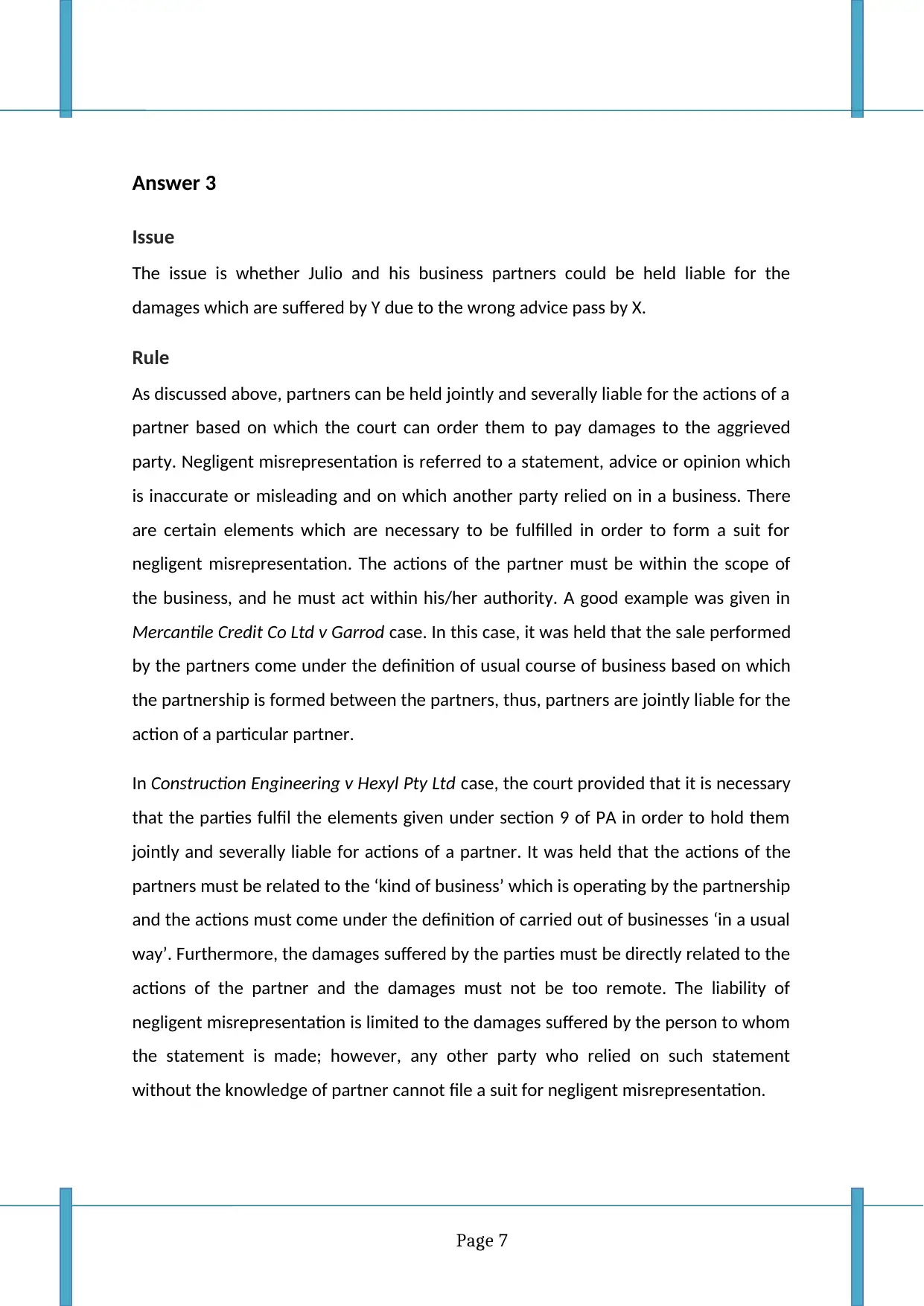
Answer 3
Issue
The issue is whether Julio and his business partners could be held liable for the
damages which are suffered by Y due to the wrong advice pass by X.
Rule
As discussed above, partners can be held jointly and severally liable for the actions of a
partner based on which the court can order them to pay damages to the aggrieved
party. Negligent misrepresentation is referred to a statement, advice or opinion which
is inaccurate or misleading and on which another party relied on in a business. There
are certain elements which are necessary to be fulfilled in order to form a suit for
negligent misrepresentation. The actions of the partner must be within the scope of
the business, and he must act within his/her authority. A good example was given in
Mercantile Credit Co Ltd v Garrod case. In this case, it was held that the sale performed
by the partners come under the definition of usual course of business based on which
the partnership is formed between the partners, thus, partners are jointly liable for the
action of a particular partner.
In Construction Engineering v Hexyl Pty Ltd case, the court provided that it is necessary
that the parties fulfil the elements given under section 9 of PA in order to hold them
jointly and severally liable for actions of a partner. It was held that the actions of the
partners must be related to the ‘kind of business’ which is operating by the partnership
and the actions must come under the definition of carried out of businesses ‘in a usual
way’. Furthermore, the damages suffered by the parties must be directly related to the
actions of the partner and the damages must not be too remote. The liability of
negligent misrepresentation is limited to the damages suffered by the person to whom
the statement is made; however, any other party who relied on such statement
without the knowledge of partner cannot file a suit for negligent misrepresentation.
Page 7
Issue
The issue is whether Julio and his business partners could be held liable for the
damages which are suffered by Y due to the wrong advice pass by X.
Rule
As discussed above, partners can be held jointly and severally liable for the actions of a
partner based on which the court can order them to pay damages to the aggrieved
party. Negligent misrepresentation is referred to a statement, advice or opinion which
is inaccurate or misleading and on which another party relied on in a business. There
are certain elements which are necessary to be fulfilled in order to form a suit for
negligent misrepresentation. The actions of the partner must be within the scope of
the business, and he must act within his/her authority. A good example was given in
Mercantile Credit Co Ltd v Garrod case. In this case, it was held that the sale performed
by the partners come under the definition of usual course of business based on which
the partnership is formed between the partners, thus, partners are jointly liable for the
action of a particular partner.
In Construction Engineering v Hexyl Pty Ltd case, the court provided that it is necessary
that the parties fulfil the elements given under section 9 of PA in order to hold them
jointly and severally liable for actions of a partner. It was held that the actions of the
partners must be related to the ‘kind of business’ which is operating by the partnership
and the actions must come under the definition of carried out of businesses ‘in a usual
way’. Furthermore, the damages suffered by the parties must be directly related to the
actions of the partner and the damages must not be too remote. The liability of
negligent misrepresentation is limited to the damages suffered by the person to whom
the statement is made; however, any other party who relied on such statement
without the knowledge of partner cannot file a suit for negligent misrepresentation.
Page 7
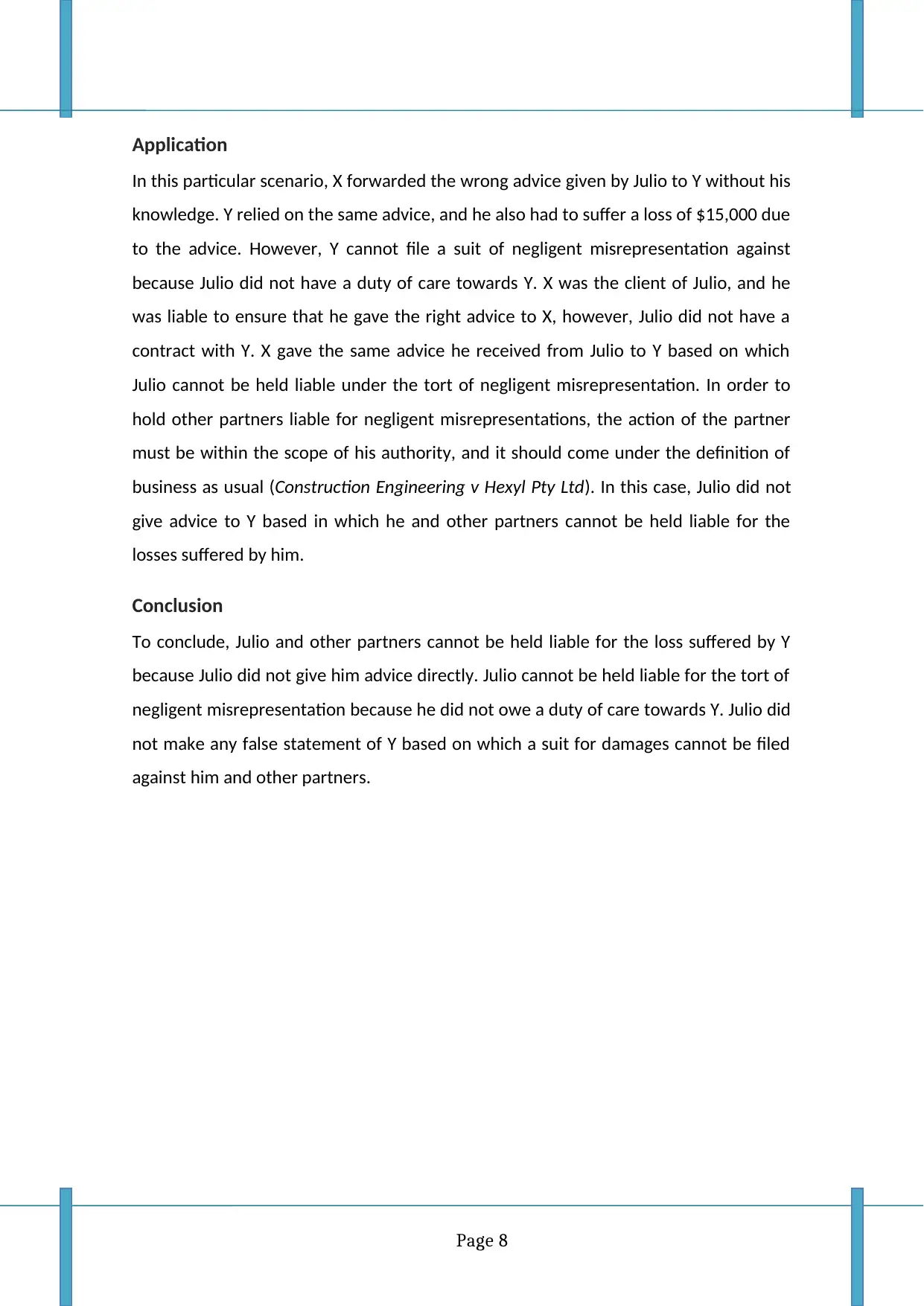
Application
In this particular scenario, X forwarded the wrong advice given by Julio to Y without his
knowledge. Y relied on the same advice, and he also had to suffer a loss of $15,000 due
to the advice. However, Y cannot file a suit of negligent misrepresentation against
because Julio did not have a duty of care towards Y. X was the client of Julio, and he
was liable to ensure that he gave the right advice to X, however, Julio did not have a
contract with Y. X gave the same advice he received from Julio to Y based on which
Julio cannot be held liable under the tort of negligent misrepresentation. In order to
hold other partners liable for negligent misrepresentations, the action of the partner
must be within the scope of his authority, and it should come under the definition of
business as usual (Construction Engineering v Hexyl Pty Ltd). In this case, Julio did not
give advice to Y based in which he and other partners cannot be held liable for the
losses suffered by him.
Conclusion
To conclude, Julio and other partners cannot be held liable for the loss suffered by Y
because Julio did not give him advice directly. Julio cannot be held liable for the tort of
negligent misrepresentation because he did not owe a duty of care towards Y. Julio did
not make any false statement of Y based on which a suit for damages cannot be filed
against him and other partners.
Page 8
In this particular scenario, X forwarded the wrong advice given by Julio to Y without his
knowledge. Y relied on the same advice, and he also had to suffer a loss of $15,000 due
to the advice. However, Y cannot file a suit of negligent misrepresentation against
because Julio did not have a duty of care towards Y. X was the client of Julio, and he
was liable to ensure that he gave the right advice to X, however, Julio did not have a
contract with Y. X gave the same advice he received from Julio to Y based on which
Julio cannot be held liable under the tort of negligent misrepresentation. In order to
hold other partners liable for negligent misrepresentations, the action of the partner
must be within the scope of his authority, and it should come under the definition of
business as usual (Construction Engineering v Hexyl Pty Ltd). In this case, Julio did not
give advice to Y based in which he and other partners cannot be held liable for the
losses suffered by him.
Conclusion
To conclude, Julio and other partners cannot be held liable for the loss suffered by Y
because Julio did not give him advice directly. Julio cannot be held liable for the tort of
negligent misrepresentation because he did not owe a duty of care towards Y. Julio did
not make any false statement of Y based on which a suit for damages cannot be filed
against him and other partners.
Page 8
⊘ This is a preview!⊘
Do you want full access?
Subscribe today to unlock all pages.

Trusted by 1+ million students worldwide
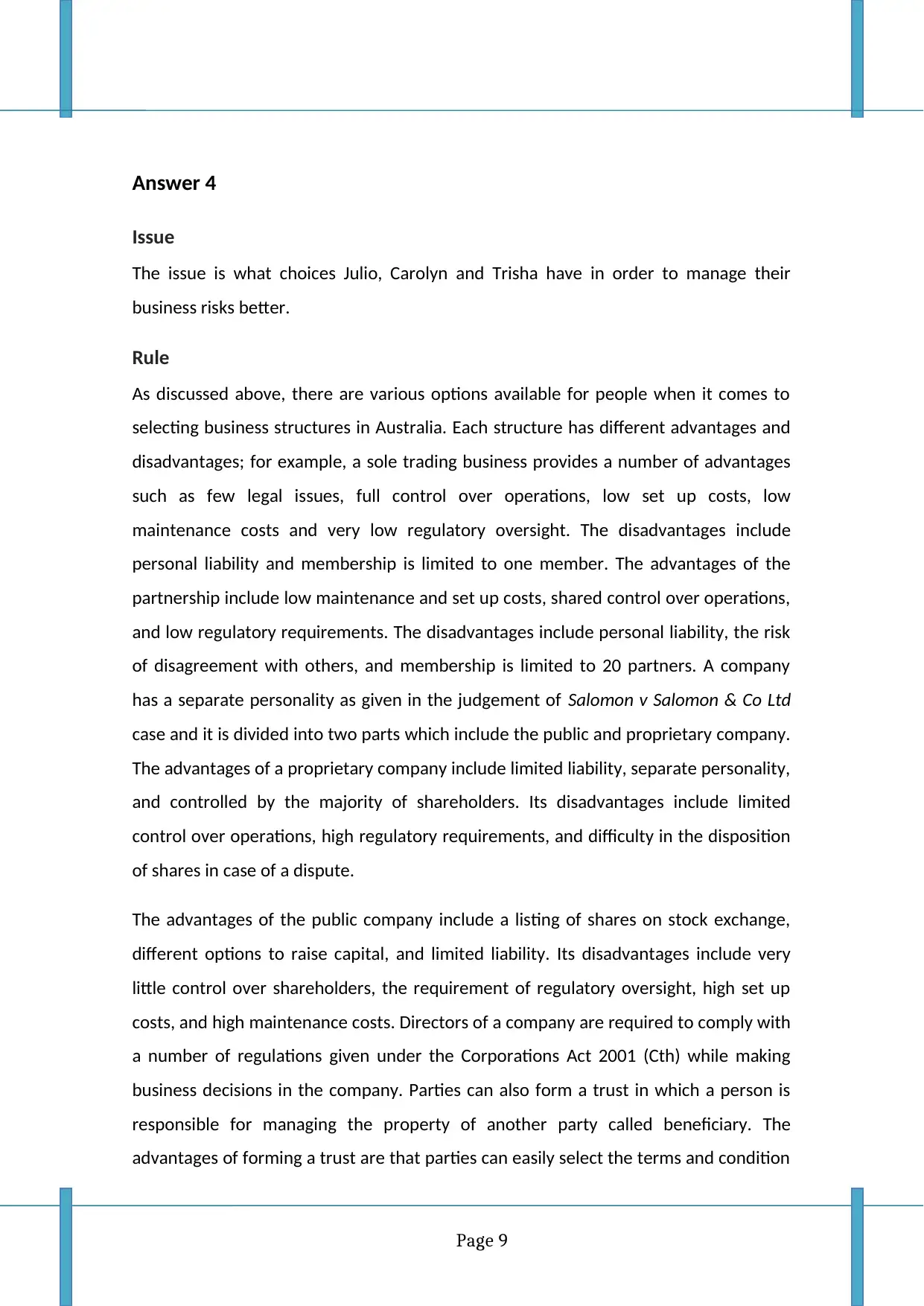
Answer 4
Issue
The issue is what choices Julio, Carolyn and Trisha have in order to manage their
business risks better.
Rule
As discussed above, there are various options available for people when it comes to
selecting business structures in Australia. Each structure has different advantages and
disadvantages; for example, a sole trading business provides a number of advantages
such as few legal issues, full control over operations, low set up costs, low
maintenance costs and very low regulatory oversight. The disadvantages include
personal liability and membership is limited to one member. The advantages of the
partnership include low maintenance and set up costs, shared control over operations,
and low regulatory requirements. The disadvantages include personal liability, the risk
of disagreement with others, and membership is limited to 20 partners. A company
has a separate personality as given in the judgement of Salomon v Salomon & Co Ltd
case and it is divided into two parts which include the public and proprietary company.
The advantages of a proprietary company include limited liability, separate personality,
and controlled by the majority of shareholders. Its disadvantages include limited
control over operations, high regulatory requirements, and difficulty in the disposition
of shares in case of a dispute.
The advantages of the public company include a listing of shares on stock exchange,
different options to raise capital, and limited liability. Its disadvantages include very
little control over shareholders, the requirement of regulatory oversight, high set up
costs, and high maintenance costs. Directors of a company are required to comply with
a number of regulations given under the Corporations Act 2001 (Cth) while making
business decisions in the company. Parties can also form a trust in which a person is
responsible for managing the property of another party called beneficiary. The
advantages of forming a trust are that parties can easily select the terms and condition
Page 9
Issue
The issue is what choices Julio, Carolyn and Trisha have in order to manage their
business risks better.
Rule
As discussed above, there are various options available for people when it comes to
selecting business structures in Australia. Each structure has different advantages and
disadvantages; for example, a sole trading business provides a number of advantages
such as few legal issues, full control over operations, low set up costs, low
maintenance costs and very low regulatory oversight. The disadvantages include
personal liability and membership is limited to one member. The advantages of the
partnership include low maintenance and set up costs, shared control over operations,
and low regulatory requirements. The disadvantages include personal liability, the risk
of disagreement with others, and membership is limited to 20 partners. A company
has a separate personality as given in the judgement of Salomon v Salomon & Co Ltd
case and it is divided into two parts which include the public and proprietary company.
The advantages of a proprietary company include limited liability, separate personality,
and controlled by the majority of shareholders. Its disadvantages include limited
control over operations, high regulatory requirements, and difficulty in the disposition
of shares in case of a dispute.
The advantages of the public company include a listing of shares on stock exchange,
different options to raise capital, and limited liability. Its disadvantages include very
little control over shareholders, the requirement of regulatory oversight, high set up
costs, and high maintenance costs. Directors of a company are required to comply with
a number of regulations given under the Corporations Act 2001 (Cth) while making
business decisions in the company. Parties can also form a trust in which a person is
responsible for managing the property of another party called beneficiary. The
advantages of forming a trust are that parties can easily select the terms and condition
Page 9
Paraphrase This Document
Need a fresh take? Get an instant paraphrase of this document with our AI Paraphraser
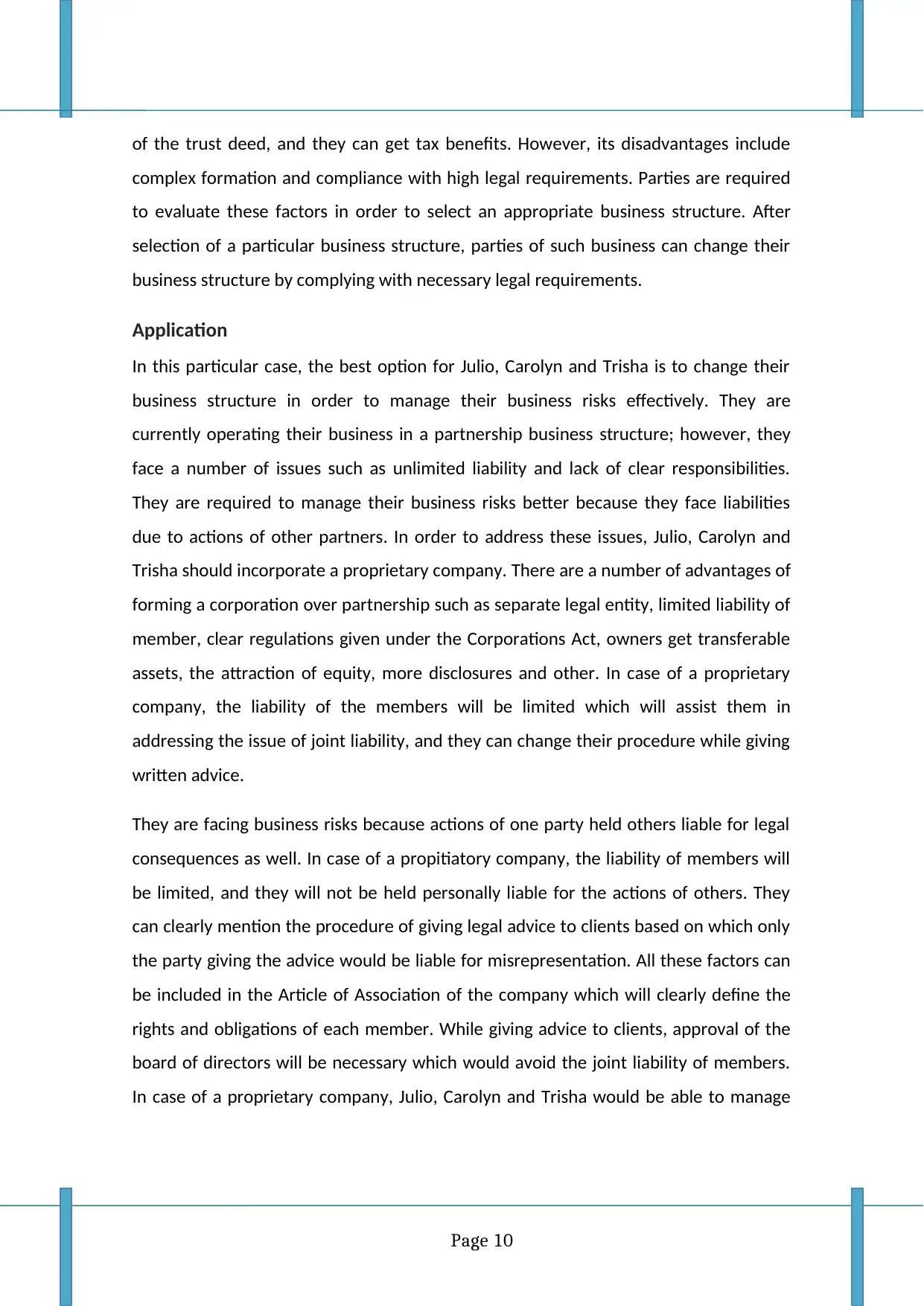
of the trust deed, and they can get tax benefits. However, its disadvantages include
complex formation and compliance with high legal requirements. Parties are required
to evaluate these factors in order to select an appropriate business structure. After
selection of a particular business structure, parties of such business can change their
business structure by complying with necessary legal requirements.
Application
In this particular case, the best option for Julio, Carolyn and Trisha is to change their
business structure in order to manage their business risks effectively. They are
currently operating their business in a partnership business structure; however, they
face a number of issues such as unlimited liability and lack of clear responsibilities.
They are required to manage their business risks better because they face liabilities
due to actions of other partners. In order to address these issues, Julio, Carolyn and
Trisha should incorporate a proprietary company. There are a number of advantages of
forming a corporation over partnership such as separate legal entity, limited liability of
member, clear regulations given under the Corporations Act, owners get transferable
assets, the attraction of equity, more disclosures and other. In case of a proprietary
company, the liability of the members will be limited which will assist them in
addressing the issue of joint liability, and they can change their procedure while giving
written advice.
They are facing business risks because actions of one party held others liable for legal
consequences as well. In case of a propitiatory company, the liability of members will
be limited, and they will not be held personally liable for the actions of others. They
can clearly mention the procedure of giving legal advice to clients based on which only
the party giving the advice would be liable for misrepresentation. All these factors can
be included in the Article of Association of the company which will clearly define the
rights and obligations of each member. While giving advice to clients, approval of the
board of directors will be necessary which would avoid the joint liability of members.
In case of a proprietary company, Julio, Carolyn and Trisha would be able to manage
Page 10
complex formation and compliance with high legal requirements. Parties are required
to evaluate these factors in order to select an appropriate business structure. After
selection of a particular business structure, parties of such business can change their
business structure by complying with necessary legal requirements.
Application
In this particular case, the best option for Julio, Carolyn and Trisha is to change their
business structure in order to manage their business risks effectively. They are
currently operating their business in a partnership business structure; however, they
face a number of issues such as unlimited liability and lack of clear responsibilities.
They are required to manage their business risks better because they face liabilities
due to actions of other partners. In order to address these issues, Julio, Carolyn and
Trisha should incorporate a proprietary company. There are a number of advantages of
forming a corporation over partnership such as separate legal entity, limited liability of
member, clear regulations given under the Corporations Act, owners get transferable
assets, the attraction of equity, more disclosures and other. In case of a proprietary
company, the liability of the members will be limited which will assist them in
addressing the issue of joint liability, and they can change their procedure while giving
written advice.
They are facing business risks because actions of one party held others liable for legal
consequences as well. In case of a propitiatory company, the liability of members will
be limited, and they will not be held personally liable for the actions of others. They
can clearly mention the procedure of giving legal advice to clients based on which only
the party giving the advice would be liable for misrepresentation. All these factors can
be included in the Article of Association of the company which will clearly define the
rights and obligations of each member. While giving advice to clients, approval of the
board of directors will be necessary which would avoid the joint liability of members.
In case of a proprietary company, Julio, Carolyn and Trisha would be able to manage
Page 10
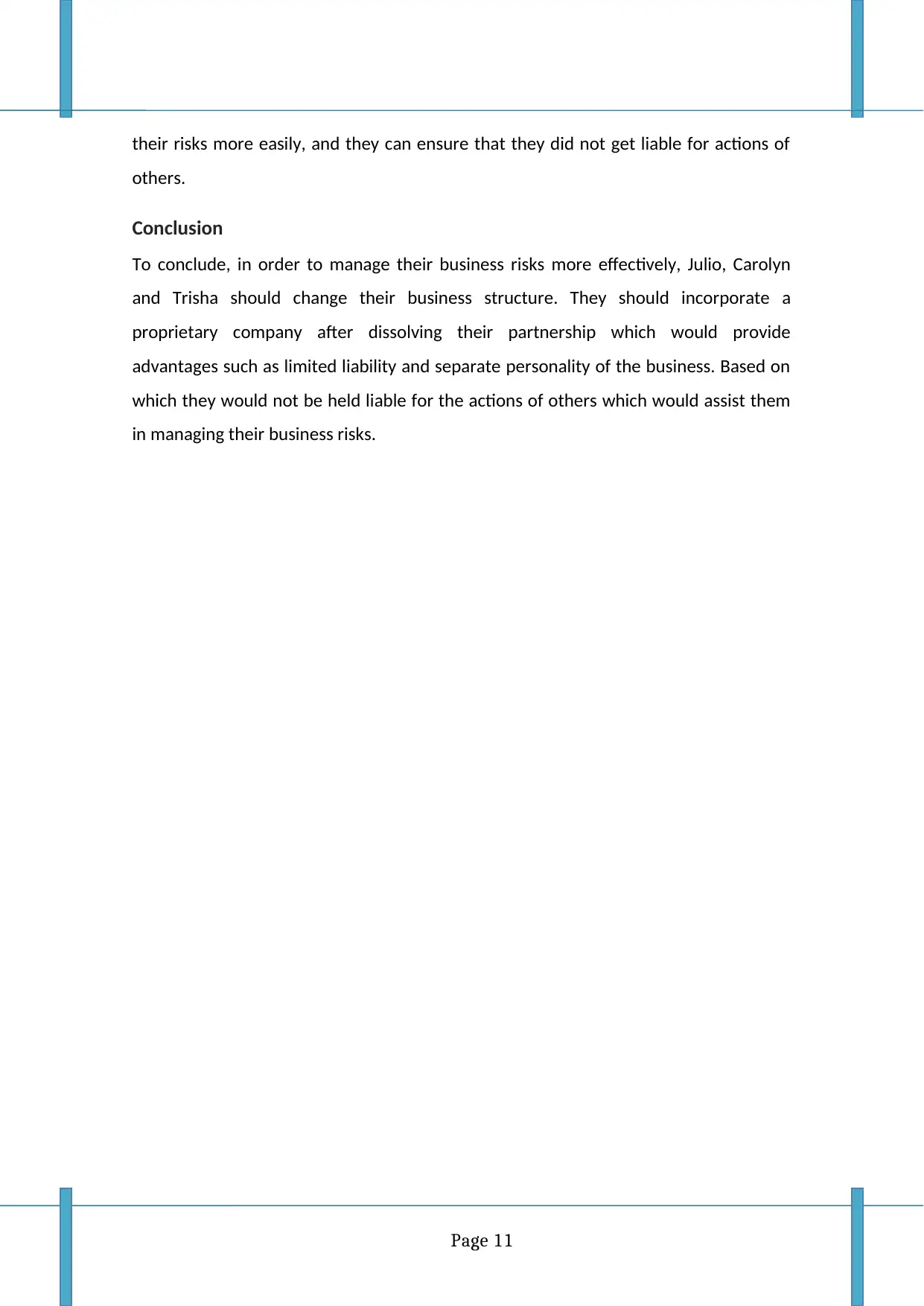
their risks more easily, and they can ensure that they did not get liable for actions of
others.
Conclusion
To conclude, in order to manage their business risks more effectively, Julio, Carolyn
and Trisha should change their business structure. They should incorporate a
proprietary company after dissolving their partnership which would provide
advantages such as limited liability and separate personality of the business. Based on
which they would not be held liable for the actions of others which would assist them
in managing their business risks.
Page 11
others.
Conclusion
To conclude, in order to manage their business risks more effectively, Julio, Carolyn
and Trisha should change their business structure. They should incorporate a
proprietary company after dissolving their partnership which would provide
advantages such as limited liability and separate personality of the business. Based on
which they would not be held liable for the actions of others which would assist them
in managing their business risks.
Page 11
⊘ This is a preview!⊘
Do you want full access?
Subscribe today to unlock all pages.

Trusted by 1+ million students worldwide
1 out of 12
Related Documents
Your All-in-One AI-Powered Toolkit for Academic Success.
+13062052269
info@desklib.com
Available 24*7 on WhatsApp / Email
![[object Object]](/_next/static/media/star-bottom.7253800d.svg)
Unlock your academic potential
Copyright © 2020–2025 A2Z Services. All Rights Reserved. Developed and managed by ZUCOL.





